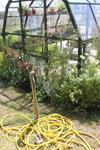 Study Hydroponics
Study Hydroponics
Hydroponics is the art of growing plants without soil. It is the perfect way to avoid heavy, back breaking work, such as digging. Pests, diseases and weeds are generally much easier to control. Over the past few decades hydroponics has proven an ideal method for both keen amateur gardeners and commercial growers looking for an alternative way of producing plants.
Lesson Structure
There are 10 lessons in this course:
- Introduction
- Scope and nature of Hydroponics
- Wick Systems
- Water Culture
- Ebb and Flow (or flood and drain system)
- Drip (with either a recovery or non-recovery process)
- N.F.T. (Nutrient Film Technique)
- Aeroponic Systems
- Hydroponics as a Global Industry
- Comparison with Soil Culture
- Resources for more information
- How a Plant Grows
- Introduction to Plant growth
- Plant Structure
- Biochemistry and Hydroponics
- Biochemical Processes; Photosynthesis, Nutrient Uptake
- Nutrients
- Nitrogen
- Phosphorus
- Potassium
- Calcium and Magnesium
- Sulphur, Iron, Zinc, Copper, Molybdenum, Carbon, Chlorine, Aluminium, Sodium
- pH
- Hydroponic Nutrient Solutions
- Preparing Nutrient Solutions
- Hydroponic Systems
- What makes up a System
- Location, Container, Water and Nutrient Application, Root Media etc
- Two simple systems
- Soil less media mixes
- Rock wool; advantages, disadvantages, manufacture, propagation blocks, rockwool applications, etc.
- NFT Systems
- Solution Dispensation Methods and Techniques
- Nutrition and Nutrition management
- Understanding Nutrient Formulae
- Writing Chemical Names
- What Nutrients Does a Plant Need
- Calculating Formulae
- Mixing Nutrients
- Symptoms of Nutrient Deficiency
- Dutch Recommendations for Nutrient Formulae
- Summary of Fertilisers or chemicals used in Hydroponic Nutrient Formulae
- Managing pH
- Managing Conductivity
-
 Plant Culture
Plant Culture
- Preparing a Flow Chart for Managing a Hydroponic Crop
- Salinity Controllers
- pH Controllers
- Post Harvest Management of Crops; cooling, drying, Canning, Control Atmosphere Storage, Relative Humidity Storage, Freezing, Vacuum Storage, etc.
- Pest and Disease Management in Controlled Environments
- Fungal Problems and Management
- Major Pest and Disease Disorders; viruses, bacteria, fungi, nematode
- Diagnosis of Crop Disorders
- Pests
- Inspecting an Unhealthy Plant
- Difficult to Diagnose Problems
- Integrated Pest Management
- Review of Diseases
- Review of Pests
-
 Hydroponic Vegetable Production
Hydroponic Vegetable Production
- Introduction
- Commercial Cultivation of Vegetables
- Propagating Vegetables
- Seed Germination of Vegetables and Herbs
- Optimum temperatures for different Vegetables
- Time from planting to harvest for different Vegetables
- Tomatoes in Hydroponics
- Eggplant in Hydroponics
- Hydroponic Lettuce
- Review of Vegetable Families (groups)
- Fresh Cut Herbs in Hydroponics
- Nutrient Solution for Herbs
- Selected Herb Crops; mint, parsley, thyme, dill basil, chives, etc.
- Hydroponic Cut Flower Production
- Introduction
- Carbon Dioxide enrichment
- Culture of Specific Hydroponic Crops
- Carnation
- Gerbera
- Gladioli
- Rose
- Indoor Plant Crops in Hydroponics
- Solid Media vs. Nutrient Film
- NFT
- Header Tank or Direct Pumping
- Solution Delivery
- Capillary Matting
- Channel Width and Length
- Slope
- Temperature
- Types of Media for Aggregate Culture
- Vermiculite
- Sand
- Perlite
- Expanded Plastics
- Expanded Clay
- Scoria
- Peat Moss
- Coir Fibre
- Composted Bark
- Review of selected Indoor Plants in Hydroponics
- African Violet
- Anthurium
- Aphelandra,
- Bromeliad
- Caladium
- Dieffenbachia
- Ferns, Ficus, Palms, etc
-
 Greenhouse Operation and Management
Greenhouse Operation and Management
- Growing Crops in Greenhouses
- Solar Energy Applications
- Greenhouse Shape, Orientation, Size, etc
- Active Solar Heating Systems
- Examples of Solar Greenhouses; case studies
- What to Grow
- Environmental Factors and how to Control them
- Heaters
- Light Factors
- Managing water with Plants
- Other Cultural Considerations; pollination, fruit cracking, ventilation, temperature, etc.
- Special Assignment
- Planning the Establishment or Management of a Hydroponic Enterprise
Each lesson culminates in an assignment which is submitted to the school, marked by the school's tutors and returned to you with any relevant suggestions, comments, and if necessary, extra reading.
Aims
- Explain different hydroponic systems.
- Select appropriate media for specified hydroponic crops.
- Describe the equipment used in hydroponic systems.
- Determine the management of nutrition in hydroponic systems.
- Explain the management of a greenhouse in the production of a hydroponic crop.
- Plan the establishment of hydroponic facility to satisfy specified criteria, both commercial and cultural.
- Develop a management plan for a hydroponic facility.
Learn How Nutrition is Managed in Hydroponics
Grown in soil, plants source the nutrients they need from decomposed organic matter, from added fertiliser, or both. Decomposed organic matter is broken down by microorganisms into its elemental form and is comprised of a range of minerals needed in order for plants to grow. The elements made available through the activity of microorganisms and other soil life are absorbed by the plant’s roots (as described earlier), but this absorption cannot occur without the presence of water since available nutrients need to be dissolved in water in order for a plant to take them up. The same applies to added fertiliser. It is added to improve the activity of soil microorganisms which break it down so that it can be used by plants. However, fertiliser needs to be added to soils in controlled amounts because too much fertiliser adversely affects the activity of (or may cause the death of) microorganisms.
In hydroponics, you circumvent the activity of soil microorganisms because firstly you are growing the plants in a sterile, soilless medium, and secondly because the hydroponic nutrients you supply are already dissolved in water and are much more directly absorbed by plant roots. In hydroponics nutrients can be added in far higher concentrations than soil fertiliser because there are no microorganisms that need to be protected.
For the reasons described above, you cannot use fertiliser in a hydroponic system and you should never use a hydroponic solution on garden soil.
